Diario di Roma Tre
Tuesday April 4, 2017
Cloudy, chance of rain 59°F/15°C in Napoli, Italia
Cloudy and breezy 65°F/18°C in Roma, EUR, Italia 00144
Partly Cloudy, Tornado Alert 75°F/24°C in Cedar Park, Texas 78613
Buongiorno,
With Mount
Vesuvius’ ancient, truncated peak watching over us, we headed off the autostrada and merged into Naples’
maddening mish-mosh of very narrow city streets and a very special breed of
crazed Italian drivers. Laura was driving, but Laura is a native Roman, and as
zany as
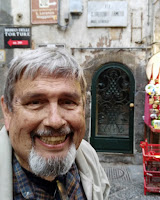 |
| MikeBo in Naples |
Rome drivers may seem to a
tourist like me, Romans don’t have driver’s licenses – they are still using learner’s permits compared to their
Neapolitan brothers and sisters. I
Napolitani are the real rocket scientists among the legions of Italian
drivers. As Laura negotiated Naples’ teeming, narrow streets, careening among
throngs of tour buses, taxis, other auto drivers and scores of pedestrians with
death wishes, I became convinced that Naples is host to all of Italy’s driving
schools. And every Italian driver, be they Milanese,
Genovese or Romani are all wanna-be Neapolitan taxi drivers. Laura was
aiming us toward the bed and breakfast she had found for us on the
internet. We were plunging onward through a neighborhood straight out of
Godfather II and turn-of-the-century Little
Italy in New York, and I was feeling as apprehensive as Sherman McCoy did
in Tom Wolfe’s Bonfire of the Vanities
when he took the wrong turn that dropped him into the bowels of the post-nuclear
South Bronx of the 1970s! Tall buildings lined the narrow street we careened
along. Michael and Laura consulted their IPhone GPS screens and gave each other
directions in Italian. I couldn’t see an inch of empty curb that might offer us
a place to park. Finally, we screeched to a stop in front of a sign reading Parcheggio! It was the garage where our
car would be safe for the night. But,
what about us, I wondered.
We grabbed our
bags and headed off down the .narrow street, dodging cars and people until the
street widened into a piazza in front of a church where a wedding was taking
place. There were so many blue and white police cars jammed into the piazza
that I thought for a moment that we had stumbled across a Neapolitan taxi
stand. Then I saw all the police, and the soldiers who patrolled in
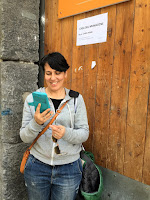 |
| Laura Waits for the Doorman |
front of
the church carrying assault rifles. Finally, we came to a boarded-up archway
with a slab door in the center and a modest sign that read Casa del Monacone, Bed and Breakfast. No doorman, no front
entrance, just a sheet of paper with Laura’s name imprinted along with a
telephone number for her to call. Laura dialed her phone, said a few words into
it, and moments later, a plywood panel at the center of the archway opened up
to reveal the smiling face of the manager. We stepped through the improvised
entrance and back in time about a thousand years. Our hotel for the night was
once the cloister for the immediately adjoining San Gennaro Church. As he
escorted us to our newly renovated
rooms, we passed by a window that gave us a pigeon’s-eye view of the
church sanctuary where the wedding was still underway.
We settled in to
our rooms to rest for a bit and freshen for the night’s adventure. Mine was a
small room with twin beds, a window that overlooked the narrow, noisy street
below. I had my own tiny bathroom with modern fixtures and a shower stall about
the size of a coffin in the corner. The room did have a TV and an
airconditioner, and it was cozy enough. But, as I took in my new surroundings,
my first thought was, Well, Botula, it’s
a first! You’ve NEVER spent the night in a church!
At 5:30, Michael
knocked at the door to say that he had a cab waiting down stairs to take to the
inaugural City Wonders Walking Tour of
the Heart of Naples. Not to worry about dinner, our
 |
| Naples Street |
food would be served to
us by local vendors as we walked along. This would be the tour’s kickoff and we
had a total of ten people along with our guide. It was a Saturday night and the
heart of Naples was jam-packed with a mixture of humanity and motorini, the swarms of the ubiquitous
motorscooters that make being a pedestrian such a hair-raising adventures. Add
a few autos to this mix of people and machines on the ancient, narrow,
cobblestone streets and you have all the elements of a life-hanging experience.
The heart of this particular tour, apart from the colorful history of Naples is
the Neapolitan street food, which has been eaten by generations of people over
the centuries. Along our path and between the munching, our guide, Cesare,
points out places of historical interest along the way and regales us with
historical tidbits about a city that was founded by the Greeks hundreds of
years before the she-wolf ever found Romulus and Remus wandering around in the
hills and took them in so they could found Rome. Naples was Rome’s first colony
in its rise to Imperial greatness, and the two cities have long enjoyed a
special relationship. Naples, with its huge port complex was
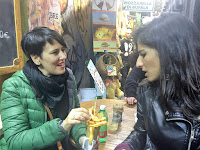 |
| Laura and Sylvia Munching |
for a long time the
gateway from the known world to the seat of Imperial power in Rome.
Our final stop
along the snack trail was the shop that specializes in the unique, citrus-based
liqueur Limoncello, a beverage built
around lemon rinds and clear grain, pure alcohol which is aged appropriately
and served in tiny glasses lest it cause irreparable brain damage to the
imbiber. At the end of our walk, Cesare, our guide continued to hold court for another
half an hour continuing to chat about the history of the city and asking for
input from his customers about future tours of this type. This was the
inaugural tour of this type for the
Naples guides and City Wonders was keenly interested in the reaction to this
type of tour. So our inaugural tour group included several company
representatives, and within a few days, I received an email with a customer
satisfaction attached. Personally, I think this type of tour is well worth the
time and effort.
After a restful
night at our converted convent we indulged in la colazione (breakfast) and then checked out so we could retrieve
our car from the garage and headed to Ercolano,
the ancient
 |
| Old Waterfront, Herculaneum |
city of Herculaneum, which was destroyed in the same volcanic
eruption that buried Pompeii in 79 AD. Michael had hired a private guide named
Marcello to show us the OTHER Pompeii! To show its appreciation of culture, the
government of Italy has decreed that all state-run museums and historic sites
will be open to the public at no charge on the first Sunday of every month. All
other times, there is an admission charge. But not today. Marcello received his
fee and a generous gratuity from us, but there was no charge for admission. I
will just skim the highlights of our visit to Ercolano, and save the juicy details for another blog.
Herculaneum was
destroyed in the same eruption of Mt. Vesuvius that buried nearby Pompeii, but
there are some significant differences in the fate of the two cities. Archaeologists have made plaster casts of the
victims of Pompeii, which were made by filling the gaps in the hardened
volcanic ash. Today you can see ghostly forms of men, women, children and even
the pets of Pompeii residents in museums and displayed at the site of the
tragedy. At Herculaneum,
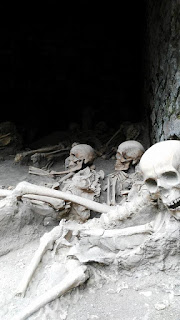 |
| Herculaneum Volcano Victims |
archaeologists have un oncovered hundreds of
skeletons, some of which still occupy the places where people died along the wa
terfront as they tried to escaped. The ancient dock area now faces a ninety
foot cliff instead of the open sea. The city was buried under one hundred feet
of lava and volcanic ash. When I
commented on Marcello’s love and enthusiasm for this ancient city, he told me
that he is not only a native Napolitano,
but his mother belonged to one of Naples oldest families. It is not unusual, he told me, to
find Napolitani who are descended from families who perished here at Ercolano! At
the end of our two hour tour we settled up with Marcello and, again bestowed a
generous gratuity. The City Wonders guides are paid emplyees, but, many of the
free-lance guide work only for the tips they receive at the end of their tours.
As a one-time bartender, I know how much people in service industries depend on
the tips they receive.
Just as I was
beginning to think that our weekend in Naples was at and end, Glauco Messina
invited all of us to join him for lunch at his brother’s restaurant in the
center of the city. So, with Laura still at the wheel we followed Glauco and
Marcello along on another wild drive through the center of Napoli, ricocheting
from side to side along the city’s narrow streets. Finally Glauco gestured for
us to park in the garage of a Carrefour
Supermercato, so we could make the short walk (he said) to il Ristorante. N
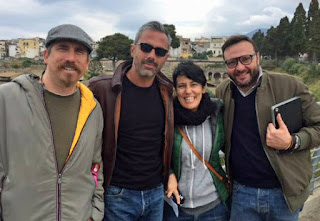 |
| Michael, Guide Marcello, Laura and Guide Glauco |
ow, if Rome is built on
seven hills, Naples must be built on fifty. Our walk began with a descent
down a long stairwell built right into the street, a not-uncommon sight in
Napoli. But, as it turned out, this would be my shortest walk of the day.
However, it was definitely worth the effort. As we entered the tiny establishment,
the aroma of fresh seafood filled the room. Glauco introduced us to his brother, who have each
one of us a menu with pages of items to choose from. But, Glauco suggested that
we pay particular attention to what his fratello
described as his recommendation as the fresh food of the day. I chose a
beef dish cooked in a sweet onions sauce over pasta a la Genovese! The antipasti was
made up of deep-fried seafoods. Delizioso!
After settling the bill for our Sunday repast, I really thought our weekend
in Naples was over and we would be heading back to Rome, finally. But, NO!
Glauco had one more thing for us to see – a view of the Bay of Naples from the
highest point in the great port city, the top of Castel San Elmo, which has protected the port and the city for many
long centuries. On this leg of our walk the long, upward staircases were
augmented by a series of long escalators built into the streets. Finally, we
reached the very top of the hill and entered the castle. Admission was free, in
accordance with Italian custom. Another ride upward, this time in an elevator,
brought us to the top of the citadel’s thick wall. What awaited us at our
destinations was a breathtaking view of the Bay of Naples, and in the distance,
at 4,400 feet, the truncated peak of Monte Vesuvius. In ancient times,
Vesuvius was three times as high, but it
literally blew its stack in 79 AD when it buried Pompeii and Herculaneum under
many feet of molten lava and superheated volcanic ash.
Along the I way
to this spectacular view I complimented Glauco on his consideration for older,
arthritic clients like me. Many of our
first-timer visitors to Italy tend to be older travelers, he
 |
| Naples and Mt. Vesuvius from Castel San Elmo |
said, plus, I know that most Americans don’t walk
as much as we Italians. So, I do my very best as a guide to show my customers
the utmost consideration towards their mobility. Smart for business, as any
first time traveler who is just back on his feet following a hip replacement
can attest. Finally the long day and its dazzling sights were at an end and
after a short walk back to the car (another considerate touch by Glauco
Messina) we said our arrivedercis and Caio’s, and headed back
through the narrow, hyper-active streets of Naples to the autostrada and our ultimate destination – Roma! It had been una bella
giornata, a beautiful day!
Ciao!
MikeBo
[Mike Botula is the author of LST 920: Charlie Botula’s Long,
Slow Target! (Amazon Books) MikeBo’s Blog
is a wholly owned subsidiary of his web site www.mikebotula.com
© By Mike Botula 2017
[2,057 words]






